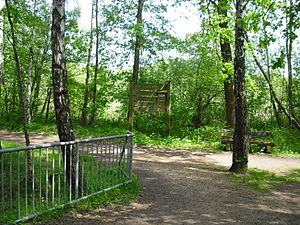Raakmoor nature reserve
|
Raakmoor nature reserve
|
||
|
Information board in the Raakmoor nature reserve |
||
| location | Hamburg , Germany | |
| surface | 33 ha | |
| WDPA ID | 82355 | |
| Geographical location | 53 ° 39 ' N , 10 ° 2' E | |
|
|
||
| Setup date | 1979 | |
| administration | BUE | |
The Raakmoor nature reserve is located in the northwest of the city of Hamburg in the Hummelsbüttel district on the border with the state of Schleswig-Holstein .
The Raakmoor consists of fen areas between broken forests and small bodies of water.
history

Today a transitional moor , the Raakmoor was a raised moor in its early days . It has been almost completely destroyed by pitting and drainage over the years, mainly to create arable land .
During the global economic crisis , the Raakmoorgraben was excavated by a voluntary labor service as a job creation measure initiated by the Hamburg SPD Senate .
After the Second World War , the responsible forest office began its first reforestation work. Initially, however, only on areas that no longer produced sufficient yield for agricultural use. Most of the areas that were afforested at the time are still preserved today.
In 1950 the Raakmoor was released as a green and recreational area. In 1956 the Horticultural Office took over the maintenance and management of the moor from the Forestry Office.
In 1977 renaturation by the horticultural authority began. The drainage ditches were filled again and by an installation of sills of Hummelsbütteler was dammed Moorgraben. This enabled the spread of the moor vegetation in the so-called core moor to be further promoted.
In 1979 the main area of the moor with a size of around 18 hectares was declared a nature reserve. It was one of the smallest in the Hanseatic city.
The Parks Department tried in 1981 by grazing by White Polled Heath , the moor grass narrow in its spread. This attempt was canceled after a year without success. In 1983 a maintenance and development plan (PEP) was drawn up for the Raakmoor. The NABU group Langenhorn / Fuhlsbüttel was officially assigned the supervision by the horticultural department. In 2004 the last settlement houses on Altenmoor were demolished and the nature reserve enlarged to around 33 hectares to the north. A new PEP was also created in 2004, after which the maintenance is still based today.
Dominating the Raakmoor is the Raakmoorgraben and the so-called reservoir, which is dammed up to a length of 300 meters. In the 1990s, parts of the Raakmoor trench were widened like a pocket, creating wet areas for controlled flooding, biodiversity and water purification.
Raakmoorteich
The up to one meter deep Raakmoortich with a sandy to muddy bottom was originally created for carp farming and is located on the edge of the nature reserve. The water has a boggy brown color, has three inlets and one outlet. In the middle of the pond there are several water lily islands and some reed edges on the edges. The species of fish that occur include bream , carp , tench , roach , rudd , mildew , gudgeon , perch , eel and pike . According to the ordinance of June 21, 2004, fishing is not permitted in the ponds of the nature reserve. The adjoining brick oaks in the south are leased by the Hamburg police officers.
flora
The majority of the Raakmoors is forested with softwood and hardwood. As part of the restoration measures again the habitat typical plants as were peat moss , bog lily , heather , bell heather and Middle and Sundew settled. In the areas of water, there are swamp Calla , Ordinary water hose , crab claw and pondweed . The nail bush grows on the bog edges .
fauna
The fauna of the Raakmoors is very diverse after the renaturation. In addition to the moor frog , adder and various types of ants, there are also a large number of dragonfly species. These include the common rush maiden and the Nordic moss maiden . The green hairstreak is one of the rare butterflies .
Web links
- The Raakmoor nature reserve on hamburg.de
- NABU Group Langenhorn / Fuhlsbüttel
- Page to the Raakmoor at the Protection Association of German Forest, Landesverband Hamburg eV
- private impressions from the Raakmoor in winter
Individual evidence
- ↑ a b National Park (NPHW) and nature reserves (NSG) in Hamburg / Status: April 2012 (PDF; 14 kB)
- ↑ a b Ordinance on the Raakmoor nature reserve of June 21, 2004
- ↑ Map of the Raakmoors ( page no longer available , search in web archives ) Info: The link was automatically marked as defective. Please check the link according to the instructions and then remove this notice.
- ↑ Raakmoorteich ( Memento of the original from June 4, 2010 in the Internet Archive ) Info: The archive link was inserted automatically and has not yet been checked. Please check the original and archive link according to the instructions and then remove this notice.
- ↑ Waterway map for angling in the Free and Hanseatic City of Hamburg, Angelsportverband Hamburg, as of May 2004





